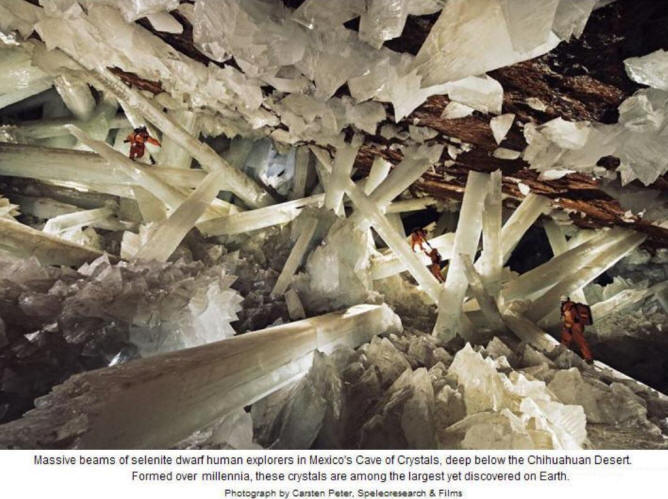
THE WORLD’S LARGEST CRYSTALS
An article published by National Geographic Magazine in November 2008 is reproduced below:
By Neil Shea, National Geographic Staff. Photography by Carsten Peter, Speleoresearch & Films.
In a nearly empty cantina in a dark desert town, the short, drunk man makes his pitch. Beside him on the billiards table sits a chunk of rock the size of home plate. Dozens of purple and white crystals push up from it like shards of glass. "Yours for $300," he says. "No? One hundred. A steal!" The three or four other patrons glance past their beers, thinking it over: Should they offer their crystals too? Rock dust on the green felt, cowboy ballads on the jukebox. Above the bar, a sign reads, "Happy Hour: 8 a.m. to 9 p.m."

This remote part of northern Mexico, an hour or so south of Chihuahua, is famous for crystals, and paycheques at the local lead and silver mine, where almost everyone works, are meagre enough to inspire a black market. "Thirty dollars." He leans in. "Ten." It's hard to take him seriously. Earlier in the day, in a cave deep below the bar, I crawled among the world's largest crystals, a forest of them, broad and thick, some more than 30 feet long and half a million years old. So clear, so luminous, they seemed extraterrestrial. They make the chunk on the pool table seem dull as a paperweight.
Nothing compares with the giants found in Cueva de los Cristales, or Cave of Crystals. The limestone cavern and its glittering beams were discovered in 2000 by a pair of brothers drilling nearly a thousand feet below ground in the Naica mine, one of Mexico's most productive, yielding tons of lead and silver each year. The brothers were astonished by their find, but it was not without precedent. The geologic processes that create lead and silver also provide raw materials for crystals, and at Naica, miners had hammered into chambers of impressive, though much smaller, crystals before. But as news spread of the massive crystals' discovery, the question confronting scientists became: How did they grow so big?
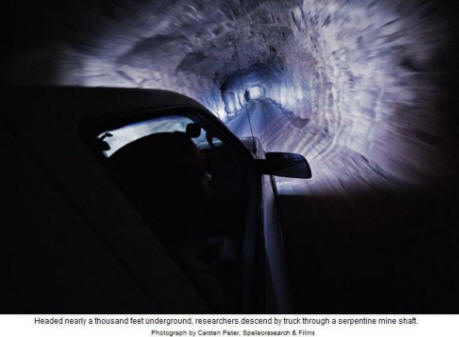
It takes 20 minutes to get to the cave entrance by van through a winding mine shaft. A screen drops from the van's ceiling and Michael Jackson videos play, a feature designed to entertain visitors as they descend into darkness and heat. In many caves and mines the temperature remains constant and cool, but the Naica mine gets hotter with depth because it lies above an intrusion of magma about a mile below the surface. Within the cave itself, the temperature leaps to 112 degrees Fahrenheit with 90 to 100 percent humidity—hot enough that each visit carries the risk of heatstroke. By the time we reach the entrance, everyone glistens with sweat.
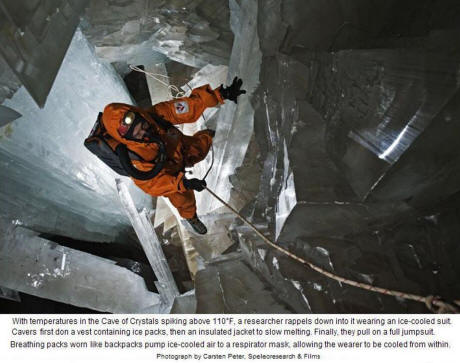
Preparing to enter the cave is like gearing up for a space walk. I pull on a vest with more than a dozen palm-size ice packs sewn into pockets across the chest and back. Then another vest to insulate the ice against the heat. Then, over everything, a bright orange caving suit. A helmet, a headlamp, a respirator mask blowing ice-cooled air. Gloves, boots. Even for cavers cocooned in all this protective gear, the heat is exhausting and dangerous; most trips inside last no more than 20 minutes. Giovanni Badino, a physicist from the Italian exploration group La Venta, leads us in.
Fallen obelisks, pillars of light, the crystals are enormous, some several feet thick. On the floor and walls are clumps of smaller crystals, sharp as blades and flawlessly transparent. Badino proceeds slowly, careful not to damage the crystals, which are made of selenite, a form of the common mineral gypsum. Selenite is translucent and soft, easily scratched by boot heels, even fingernails. Despite the ice suits, the heat and humidity are oppressive. I remove the mask for a moment and suck in wet, hot air. My lungs want to refuse it. There is a damp, heavy scent of earth and an absolute stillness. Miserable conditions for humans, a perfect nursery for crystals.
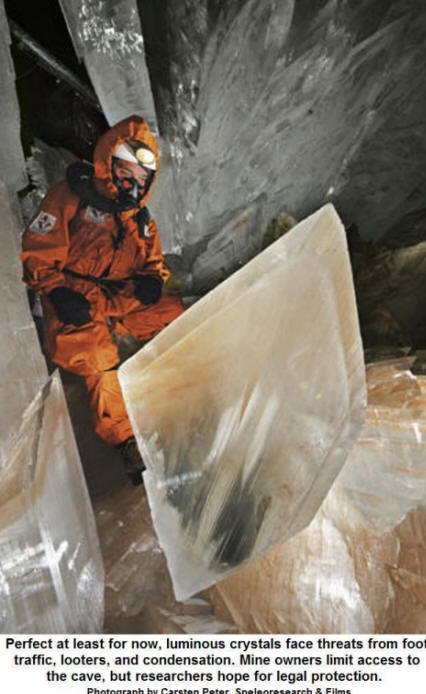
In their architecture crystals embody law and order, stacks of molecules assembled according to rigid rules. But crystals also reflect their environment. Spanish crystallographer Juan Manuel García-Ruiz was one of the first to study the Naica crystals beginning in 2001. More familiar with microscopic crystals, García was dizzied by the proportions of the Naica giants. By examining bubbles of liquid trapped inside the crystals, García and his colleagues pieced together the story of the crystals' growth. For hundreds of thousands of years, groundwater saturated with calcium sulphate filtered through the many caves at Naica, warmed by heat from the magma below. As the magma cooled, water temperature inside the cave eventually stabilized at about 136°F.
At this temperature minerals in the water began converting to selenite, molecules of which were laid down like tiny bricks to form crystals. In other caves under the mountain, the temperature fluctuated or the environment was somehow disturbed, resulting in different and smaller crystals. But inside the Cave of Crystals, conditions remained unchanged for millennia. Above ground, volcanoes exploded and ice sheets pulverized the continents. Human generations came and went. Below, enwombed in silence and near complete stasis, the crystals steadily grew. Only around 1985, when miners using massive pumps lowered the water table and unknowingly drained the cave, did the process of accretion stop.
In the presence of such beauty and strangeness, people cast around for familiar metaphors. Staring at the crystals, García decided the cavern reminded him of a cathedral; he called it the Sistine Chapel of crystals. In both cathedrals and crystals there's a sense of permanence and tranquillity that transcends the buzz of surface life. In both there is the suggestion of worlds beyond us.
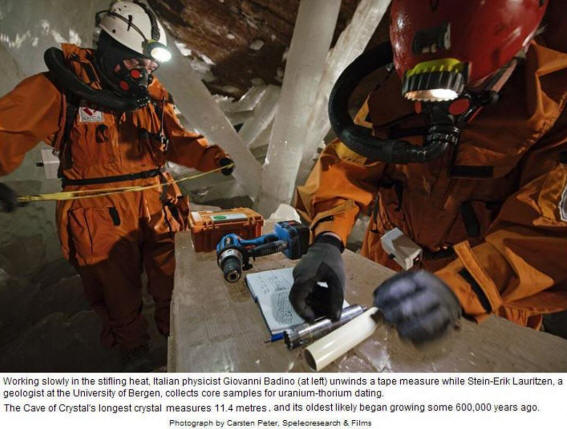
Now, in the cave, a team of scientists and explorers is conducting research and working on a documentary. Stein-Erik Lauritzen, a professor of geology at the University of Bergen in Norway, is retrieving samples for uranium-thorium dating. His preliminary research suggests the largest of the crystals are about 600,000 years old. Penelope Boston, an associate professor of cave and karst science at New Mexico Tech, searches for microbes that might live among the crystals. In some of them, tiny bubbles of suspended fluid—the kind García studied—sparkle in our lights. They are little time capsules: Italian scientists led by Anna Maria Mercuri extracted pollen that may have been trapped within these inclusions. The grains appear to be 30,000 years old and suggest that this part of Mexico was once covered not by desert but by forest.
One long, slender beam bears a deep scar from where someone tried to cut through it. I imagine a miner dripping and alone in the smothering silence, his weak headlamp bouncing with each saw stroke. Collectors might pay tens of thousands of dollars for a crystal from this cave. Whoever he was, he quit before he could sever the crystal, and mine owners later installed a heavy steel door to deter looters. So far it has worked, but who knows if it will last. Miners, after all, have access to drills and explosives. And while mining and construction projects can be halted to save archaeological relics, minerals in Mexico have no such protection.
The crystals could also be threatened by the lack of water. When the cave was filled, water helped support and preserve the beams. Now, with the cave empty and open to air, they may over time bend or crack under their own weight and become dull, as gases such as carbon dioxide wash in. The director of the mine told me his company, Peñoles, is dedicated to preserving them, but the company's main interest isn't crystals, and the basic activities of mining—blasting, trucks stirring up dust—threaten the gallery. Badino and others hope to convince the company to do more (lobbying for UNESCO World Heritage status has been mentioned), but so far the crystals exist in limbo, probably more famous outside Mexico than within.
We stop for a moment to rest. Everything around us glitters; it is as though we are standing inside a star. Badino turns, and the lines crease at the corners of his eyes. He pulls his mask away. "You know," he says, smiling, "there would be worse places to die."
Cathedral, star, tomb. We look for something to anchor the otherworldly in the familiar. After half an hour we depart, soaked in sweat, our veins throbbing, and a visiting filmmaker asks what it was like. I have a little trouble. He nods, understanding.
"Es como un sueño de niño," he says. "It is like a child's dream."
National Geographic Magazine printed this short article in November 2008
Go to this National Geographic site: http://ngm.nationalgeographic.com/2008/11/crystal-giants/shea-text/1
You can read the article of 3 web pages, by clicking on the words “Feature Article”.
You can see the pictures for the article by clicking on the words “Photo Gallery”, and then clicking on individual thumbnail pictures. There are 12 good pictures there.
You can see a 2 and a half minute video on the matter by clicking on the word “Video”. This link opens a web page where many National Geographic short videos are located. You need to scroll down with the red links scroller, not the page scroller, to find the link in red “Crystal Caves”.
http://ngm.nationalgeographic.com/video/player#/?titleID=1842856752 <<< this is the link that appears when the video is playing.
Click on it several times until the extremely annoying advertising videos stop playing and the caves video loads then plays.
If the above main link fails, you can go to : www.NationalGeographic.com , click on the link National Geographic Magazine, and when that opens, click on the link Archives, then click on the Alphabet letter C, then click through a couple of pages of “C” topics, and click on Link “Cave of Crystals Crystal Palace” and the article page will open.